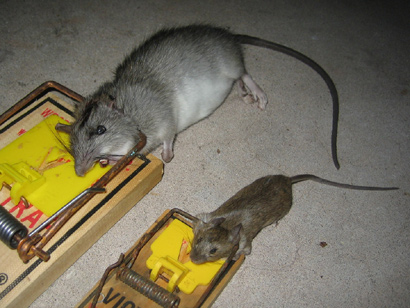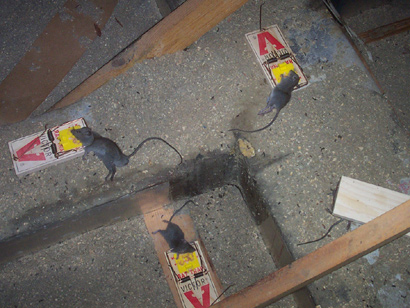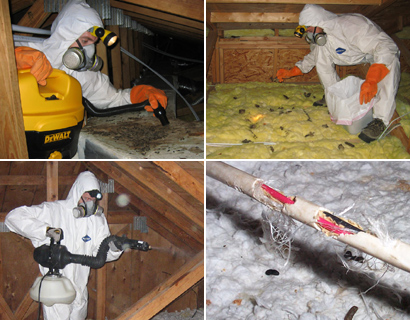- Mouse and Rat Removal - Information about the humane trapping and removal of rats and mice.
Mouse and Rat Removal
COMMON PROBLEMS: Rats and Mice thrive in urban areas, and very commonly live inside houses, in the attic, walls, and other areas. They often enter the house and scavenge for food. They can chew on electrical wires, they reproduce very quickly, and they can fill an attic with thousands of droppings, and spread diseases. You will likely hear them scurrying and scratching in the ceiling or walls at night. They cause some of the following problems:
- Living, nesting, and breeding in the attic of a house.
- Scampering up and down the walls inside a house.
- Entering the living space, such as the kitchen, and chewing or eating food.
- Chewing on electrical wires (fire hazard) or pipes (flood hazard).
- Leaving behind hundreds or even thousands of droppings in the attic or house.
- Risk of diseases, such as Hantavirus Pulmonary Syndrome, Murine Typhus, Rat-bite fever, Salmonella, Leptospirosis, and more.
POISON-FREE MOUSE AND RAT CONTROL: Poison is a horrible approach to rodent control. This is the most important single thing for you to know regarding a rat or mouse problem. Poison is a lazy and inneffective approach. It's meant to make long-term profits for pest control companies, at your expense.
- Poison never kills ALL the rodents - more just keep coming into the building.
- Poison leaves dead, rotting, rodents in your attic and walls, and it STINKS!
- Poison is far less humane than instant-death lethal snap trapping, if you care.
- Poison is a temporary and incomplete approach - it never addresses the root cause of the rodent problem.
HOW DO WE DO IT? The key is to inspect every last portion of your house, inside and out, find out how the rodents are getting in, and seal those areas shut with non-chewable stee. Repairs are a crucial step in the mouse and rat removal process. In all cases, sealing the entry holes shut ensures that no future rodents will ever enter your home. Entry hole repairs are absolutely necessary during the process of removing rats and mice. These vermin usually have many entry holes into a house. It is futile to attempt trapping them until all the entry holes are sealed FIRST. Only then is it effective to trap and remove the rodents inside the attic/house, and it is surprisingly easy to do so once they are not able to follow their normal routes outside.
- 100% of the entry holes must be found, and sealed shut, or the job is not complete.
- Our repairs are professional contractor grade, and we use steel, which rodents such as rats or mice are unable to chew through.
- We give a written guarantee on our repairs against any future rodent entry.
ATTIC DECONTAMINATION & OTHER SERVICES: In some situations, it may be desirable to clean your attic after you've removed rats and mice from the space. They can leave behind large amounts of droppings, urine, hair, oils, food, nesting material, and so on. These remnants can attract insects like cockroaches, and the scent left behind can encourage new rats and mice to attempt to chew or break their way into your house. You might also experience odor problems from the waste. It's possible or likely that mold will grow on the areas of feces and urine, and urine can damage wood or sheetrock. Some of the mold can potentially cause diseases that people can catch, and some of the feces themselves can cause diseases, such as Salmonella or Leptospirosis. It's also adviseable to repair any torn ductwork in an attic, along with any torn pipe insulation or chewed electrical wires.
- We remove or vacuum all droppings, or remove all the soiled insulation.
- We fog the attic with a special enzyme-based cleaner that destroys any organic matter and deodorizes the space.
- We repair damage, such as ductwork, electrical wires, pipes, insulation, and more.
Learn more about whether or not rats dig holes. We also have advice about keeping rats out of your garden, as well as your garbage. If you already have rats on your property, we highly recommend using one-way exclusion funnels to remove rats without trapping them, as well as provide a list of all of the equipment that is needed to trap a rat. (Read here an analysis of glue traps for rats and learn why we find them to be inhumane.) We can even answer How do you remove a rat stuck in a dumpster as well as whether or not Do dogs keep rats and mice away?. There are plenty of good reasons to get rid of rats quickly - read here about whether or not rat feces is dangerous to touch or breathe as well as What diseases do rats carry.
We can offer some insight about whether you should hire a pro, or remove rats yourself, and let you know What property modifications will keep down rat populations. Find out about how rat poison works and whether or not rats enter buildings through plumbing. Learn How to get rid of rats outside and whether or not rats make good pets. I have advice on how to get rats out of the attic and can inform you on Rats Mating and if a rat in the attic will have a nest of babies. Learn, too, if rats kill mice.
More information in the articles below:
How To Get Rid of Rats - Tips and steps for getting rid of rats.
Rat Prevention - Preventative methods for how to keep rat away from your property.
How To Trap a Rat - Methods for catching rat in cage traps.
Rat in the Attic - Info about what to do if you have rat in the attic.
How to Kill a Rat - Does poison work to kill rat? Is killing rat the best approach?
Rat in Your House - Tips on how to get a rat out of hour house.
Rat Feces - Pictures of rat poop and info about danger, and diseases from rat droppings.
Rat Repellent - Analysis of various rat deterrents and repellent products.
What Bait Catches Rat - What kind of food do you put in a trap to catch a rat?
Rat on the Roof - If you hear scratching on the roof, and think it's a rat.
Rat Poison - What are the available types of rat poison? Are they legal?
Dead Rat - Removal of a dead rat in the house or on the property.
Diseases from Rat - Analysis of what kinds of diseases rat can carry and cause in humans.
Rat Urine - Information about rat pee, and the dangers or diseases of rat urine.
Rat in the Walls - What to do if you hear rat in the walls, scratching.
Learn about the biology of the Norway rat and what attracts rats. Read about humane mouse traps and my analysis of inhumane glue traps. Learn how to keep mice out of your garden and garbage. Find out what kind of damage mice can cause in an attic, and if mice chew on wires. I can show you how to get mice out of the attic and what to do if you find you have a house mouse inside your house. Learn to use one-way exclusion funnels to remove mice, which is my most recommended method.
Find out about the diseases mice can carry, and learn about a mouse's natural diet. Learn what mice can chew through and what they can climb. I can let you know if cage traps are a good option for mice, and what might be attracting them to your property in the first place. I can also let you know if mothballs or ammonia really help to repel mice.
Read about the rat's natural diet and if rats will destroy insulation in an attic. I can show you how to find and remove a dead rat and just how much damage rats can cause in the attic. Learn what rats can climb on, and how to clean rat feces out of your attic. Learn what rats chew and if rats really eat cheese. I can tell you what to do with a rat after you catch it and if cats really help to keep cats away. Learn if cage traps a good option for rats, and find out the biology of a Black Rat. Read about the best bait to trap a rat, and what you should do if you find a nest of rats in your attic.
Learn how to get rid of rats in the attic and what animals rats kill. I can let you know if mothballs or ammonia help repel rats, and if animal services will help with a rat issue. Find out if rats chew on wires and what wildlife rehabilitators do with rats. I can teach you how to get rats out of a wall and let you know where you can relocate a trapped rat. Find out if mice or rats are easier to trap and if rats live in more urban or wild areas. I can let you know if it is legal to trap a rat, and inform you of how rats communicate using pheromones.
Learn if rats can swim and if relocated rats survive. Read about the different types of rat snap traps and if a strobing light or high pitch sound deterrent machine work on rats. Read about how big rats can get, and learn the symptoms of sick rat. Find out what to do about a trap-shy rat, and what to do about a rat on the roof. Find out repellents will get a rat out of the attic and if a pest control company will remove a rat.
North American Rats Biology and Information
There are two very common rats that are found in the United States, the Norway rat (Rattus norvegicus), and the Black rat (Rattus rattus) sometimes called the Roof rat. Both of these animals have the same characteristics yet live in different climates. The Norway rat is slightly bigger and therefore stays closer to the ground, while the Black rat will be seen in trees, attics, and high rise buildings.
Biology - Rats are omnivores which mean that they will eat just about anything. They are not picky eaters and will eat on anything that is available. They love human food which is why the rats live in close proximity to people. Adults will eat up to fifteen grams a day, and drink about the same amount in water. Their often like to live near water because they can get a lot of food from it. The rats will also feed on birds and insects. These omnivores are very hardy and are considered very difficult to get rid of. They are considered a health hazard since their blood can carry so many different types of bacteria. Rats are known to be aggressive not only with their own kind, but with other animals, as well as humans, and have been known to bite when confronted.
Life Cycle and Reproduction - Rats have a short life span of about one year in the wild, but can live up to two or three years in ideal environments. Although rats are agile and can escape very quickly, they are a source of food for many small animals. They have many predators, but especially owls and cats in domesticated areas, and foxes, coyotes and weasels in open areas. These pests can have up to eighty babies which is why an infestation of rats is hard to get rid of. They are capable of mating within the first six to eight weeks of their life and can have up to twenty four babies in a litter. There is no breeding period but they can have babies year round. The female has a gestation period of 28 days and can get pregnant immediately afterwards. Most females will begin the process of nesting right after becoming pregnant and will stay close to their home until after the weaning period which is about four weeks.
Habitat - These very resilient creatures will borrow for long distances from the habitat to their food source to avoid their predators. These tunnels can run four feet deep and several yards away. Rats can scale walls, walk on telephone wires and swim in open water, so they will nest just about anywhere and still be safe. Rats are found in deserted buildings, barns, as well as, holes in walls and attics. Their nests are usually material that has been shredded, and can be anything from sticks to plastics to whatever they can find. It is not uncommon for a nest to have up to sixty rats in one location. Rats are nocturnal and find their food at night, then sleep during the day.
Common Diseases These Animals Can Spread - Rats are able to carry more viruses and bacteria in their bloodstream than any other known rodent. Because of this, the diseases that the rat can carry are very dangerous to humans as well as pets. Rats are the mainstream transporter of disease in the world with such pathogens such as the bubonic plague, Weil’s disease and more. They are especially known to carry that strep bacterium that can cause severe diseases in humans such as pneumonia.
Common Nuisance Complaints - There are major complaints when it comes to rats. They can contaminate food with their droppings and urine. The habit of gnawing on anything can destroy property and sometimes cause a fire risk. Rats can destroy plant life with their burrowing and eat vegetables from a garden. They carry deadly diseases that can harm people. Their nests can become infested with rats into such high numbers they can take over a whole area.
Although the methodology is pretty much exactly the same as for rats, I have written a specific Mouse Removal page with more information.





